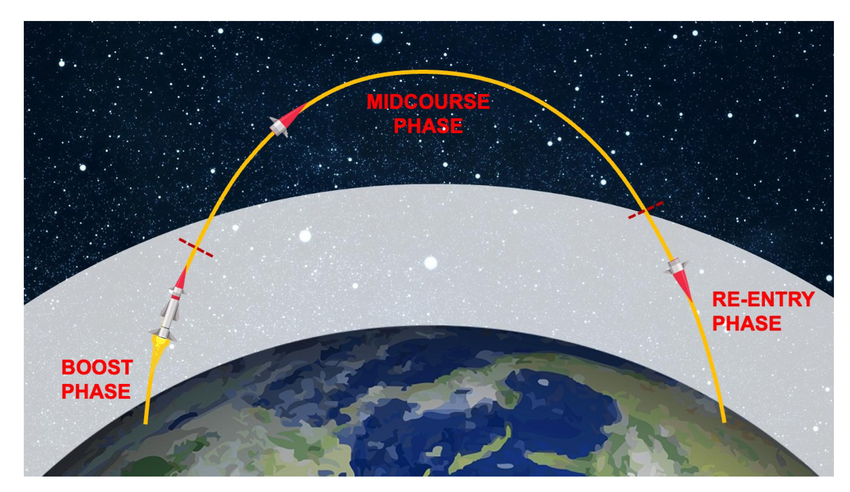Ballistic Missiles — Gravity’s Deadliest Weapon
Ballistic missiles are among the most powerful and strategically important weapons ever developed. They aren’t equipped with fancy sensors or target-tracking technology. Instead, they rely on the raw forces of physics — particularly gravity, momentum, and velocity — to strike targets with incredible speed and force.
In this post, we'll break down exactly how ballistic missiles work, the science behind their flight path, and what makes them so formidable.
What Exactly Is a Ballistic Missile?
A ballistic missile is a high-powered projectile that is launched into the upper layers of the atmosphere — or even space — and then allowed to fall back toward its target, following a curved path known as a ballistic trajectory. This trajectory is determined by the missile’s initial launch velocity, the angle of launch, and gravity.
After the launch phase, the missile does not receive any further propulsion or control inputs. It simply coasts along its arc, much like a thrown rock — only at hypersonic speeds and with far more destructive consequences.
Okk, I heard you, ballistic trajectory refers to the curved path an object takes when it is propelled into the air and then falls back under the influence of gravity, with no further propulsion after launch. Refer this image:
This arc-like path isn’t random — it’s governed by the laws of classical mechanics. Once the missile is in flight, there's no turning back, no redirection.
Phases of Ballistic Missile Flight
The operation of a ballistic missile can be broken down into three distinct phases, each with specific characteristics.
1. Boost Phase
-
Begins at launch.
-
The missile is powered by rocket engines that generate immense thrust.
-
This phase typically lasts 1 to 5 minutes, depending on the missile’s size and type.
-
The goal is to accelerate the missile out of the lower atmosphere and into a stable ballistic trajectory.
-
At the end of this phase, the engines shut off, and the missile becomes a high-speed projectile.
2. Midcourse Phase
-
The missile now coasts through space in a vacuum.
-
This phase is the longest, often lasting 20 minutes or more for intercontinental ballistic missiles (ICBMs).
-
If the missile is equipped with MIRVs (Multiple Independently targetable Reentry Vehicles), this is when they are released and begin following their own trajectories toward multiple targets.
3. Reentry Phase
-
Gravity pulls the warhead(s) back into the Earth's atmosphere.
-
The vehicle undergoes intense aerodynamic heating — its surface can reach thousands of degrees Celsius.
-
Despite this, the warhead must survive and maintain structural integrity.
-
Upon reentry, the missile can be traveling at speeds exceeding Mach 20, making interception extremely difficult.
-
The warhead descends rapidly and impacts its target with high kinetic energy, in addition to any explosive payload.
Types of Ballistic Missiles
Ballistic missiles are classified based on their range — the maximum distance they can travel.
| Type | Range |
|---|---|
| Short-Range Ballistic Missile (SRBM) | Up to 1,000 km |
| Medium-Range Ballistic Missile (MRBM) | 1,000 – 3,000 km |
| Intermediate-Range Ballistic Missile (IRBM) | 3,000 – 5,500 km |
| Intercontinental Ballistic Missile (ICBM) | Over 5,500 km |
Each type serves a different military purpose, from tactical battlefield use to long-range nuclear deterrence.
Notable Ballistic Missiles
-
Minuteman III (USA) – One of the oldest operational ICBMs, carrying up to three MIRVs.
-
Agni-V (India) – A long-range missile with strategic deterrence capabilities.
-
DF-41 (China) – Reportedly China’s most powerful ICBM, capable of reaching most of the globe.
Can Ballistic Missiles Be Intercepted?
In theory, yes — but in practice, it's extremely challenging.
Their high altitude, extreme velocity, and short warning times make interception a race against physics. Missile defense systems like THAAD and Arrow-3 are designed to intercept them during either midcourse or reentry, but success depends heavily on timing, radar tracking, and the ability to distinguish real warheads from decoys.
Even in an age of drones, cyber warfare, and precision strikes, ballistic missiles remain one of the most important tools in a nation’s strategic arsenal. Their power lies not just in destructive potential, but in the psychological and geopolitical weight they carry. They are, quite literally, weapons of gravity — simple in principle, yet devastating in execution.




Comments
Post a Comment